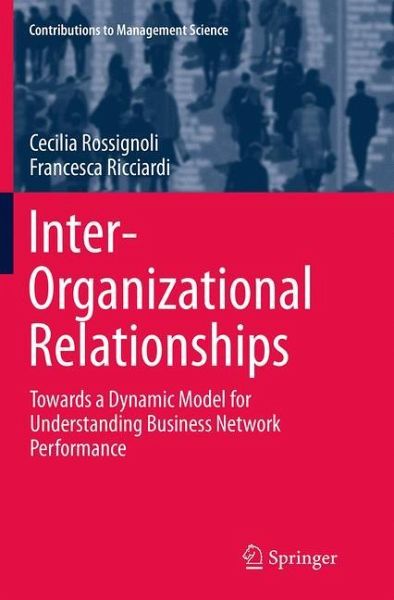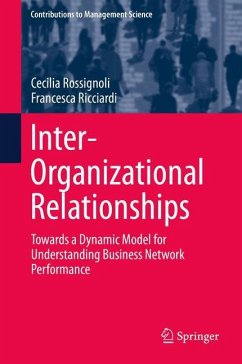
Inter-Organizational Relationships
Towards a Dynamic Model for Understanding Business Network Performance
Versandkostenfrei!
Versandfertig in 6-10 Tagen
38,99 €
inkl. MwSt.
Weitere Ausgaben:

PAYBACK Punkte
19 °P sammeln!
This book explores the premise that organizations are significantly influenced by their inter-organizational relationships; moreover, these relationships may generate important externalities, both positive and negative, impacting the environment at several levels. The advent of the Internet era, on the other hand, has resulted in disruptive changes in traditional inter-organizational networks, and some completely new inter-organizational settings are now arising.In its first part the book reviews the most commonly cited theories explaining inter-organizational phenomena: transaction costs econ...
This book explores the premise that organizations are significantly influenced by their inter-organizational relationships; moreover, these relationships may generate important externalities, both positive and negative, impacting the environment at several levels. The advent of the Internet era, on the other hand, has resulted in disruptive changes in traditional inter-organizational networks, and some completely new inter-organizational settings are now arising.
In its first part the book reviews the most commonly cited theories explaining inter-organizational phenomena: transaction costs economics, agency theory, resource dependence theory, game theories, collaborative networks theory, institutional theories, organizational ecology, resource-based / relational-based view of the firm, and knowledge network / social network theories. In Part II it thoroughly reviews the literature on a number of key IT-enabled inter-organizational systems currently on the rise, such asvirtual organizations, e-intermediators and e-marketplaces.
Lastly, Part III presents the case of the Yoox Group, a leading firm offering e-commerce services for fashion and design products. A framework is proposed for systematically linking the different possible types of inter-organizational relationships to specific, suitable sets of theories. The range of possible inter-organizational relationships is described on the basis of three pairs of opposites: conformism-breach, exploitation-exploration, and cooperation-competition. This results in a model that makes it possible to combine different theories in order to study the effects of inter-organizational ambidexterity and dynamism on performance.
In its first part the book reviews the most commonly cited theories explaining inter-organizational phenomena: transaction costs economics, agency theory, resource dependence theory, game theories, collaborative networks theory, institutional theories, organizational ecology, resource-based / relational-based view of the firm, and knowledge network / social network theories. In Part II it thoroughly reviews the literature on a number of key IT-enabled inter-organizational systems currently on the rise, such asvirtual organizations, e-intermediators and e-marketplaces.
Lastly, Part III presents the case of the Yoox Group, a leading firm offering e-commerce services for fashion and design products. A framework is proposed for systematically linking the different possible types of inter-organizational relationships to specific, suitable sets of theories. The range of possible inter-organizational relationships is described on the basis of three pairs of opposites: conformism-breach, exploitation-exploration, and cooperation-competition. This results in a model that makes it possible to combine different theories in order to study the effects of inter-organizational ambidexterity and dynamism on performance.














